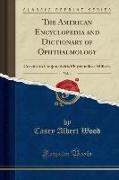The American Encyclopedia and Dictionary of Ophthalmology, Vol. 4
BücherAngebote / Angebote:
Excerpt from The American Encyclopedia and Dictionary of Ophthalmology, Vol. 4: Cocaine to Conjunctivitis Phlyctenulosa MiliarisCocaine. Erythroxyline. Methyl-benzoyl-ecgonine. This agent, so extremely important from the standpoint of the Ophthalmic surgeon, is derived from the leaves of erythroxylum coca, with the formula c17h21n04. It is the best known and one of. The most useful local anesthetics we possess. This alkaloid is present in coca to the extent of about one-half of one per cent. And occurs in the shape of colorless prisms, soluble in 600 parts of water, five of alcohol, twelve of olive oil, insoluble in lard and vaselin. The hydrochloride is its best known salt, although the benzoate, borate, citrate, hydrobromide, hydriodide, lactate, nitrate, tartrate, salicylate, phenate, oleate, stearate (best for ointments), and sulphate are well known. The National For mulary recommends cocaine borate instead of the hydrochloride in solutions intended for ocular use on account of its greater stability.The most frequently used incompatibilities with cocaine and its salts are its combination in solution with zinc sulphate and sodium borate, both of which precipitate it.As the hydrochloride is incompatible with silver salts cocaine nitrate should be used in lieu of the hydrochloride when argentic compounds are prescribed with it.In the usual dosage, 3 to 5 per cent., it dilates the pupil moderately, is a feeble cycloplegic, produces anemia of the conjunctiva and is a dangerous poison. The drug greatly increases the action of other alkaloids with which it is instilled into the conjunctival sac, probably because its desiccating and loosening action on the anterior corneal epithelium enables the solution to reach more easily the substantia propria. The eyes should always be kept closed during the first stages of cocain instillation as this largely neutralizes the hurtful action of the drug on the cornea. Michel goes even further than this in claiming that the exfoliation of the pavement epithelium may be so marked as to justify calling the condition cocain keratitis and advises one to cover the eye with a moist compress when strong solutions are used or the drug applied for any length of time. It is claimed that this agent may precipitate an attack of glaucoma, while even from simple instillations into the eye of a comparatively weak solution toxic symptoms (vertigo, pallor of the face, fainting, thick speech, weak pulse, loss of consciousness, occasionally silow themselves, requiring alcoholics, amyl nitrite inhalations and other stimulation for their relief.About the PublisherForgotten Books publishes hundreds of thousands of rare and classic books. Find more at www.forgottenbooks.comThis book is a reproduction of an important historical work. Forgotten Books uses state-of-the-art technology to digitally reconstruct the work, preserving the original format whilst repairing imperfections present in the aged copy. In rare cases, an imperfection in the original, such as a blemish or missing page, may be replicated in our edition. We do, however, repair the vast majority of imperfections successfully, any imperfections that remain are intentionally left to preserve the state of such historical works.
Folgt in ca. 5 Arbeitstagen

